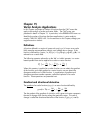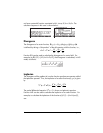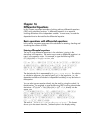
Page 15-4
not have a potential function associated with it, since, ∂f/∂z ≠∂h/∂x. The
calculator response in this case is shown below:
Divergence
The divergence of a vector function, F(x,y,z) = f(x,y,z)i+g(x,y,z)j+h(x,y,z)k,
is defined by taking a “dot-product” of the del operator with the function, i.e.,
Function DIV can be used to calculate the divergence of a vector field. For
example, for F(X,Y,Z) = [XY,X
2
+Y
2
+Z
2
,YZ], the divergence is calculated, in ALG
mode, as follows:
Laplacian
The divergence of the gradient of a scalar function produces an operator called
the Laplacian operator. Thus, the Laplacian of a scalar function φ(x,y,z) is given
by
The partial differential equation ∇
2
φ = 0 is known as Laplace’s equation.
Function LAPL can be used to calculate the Laplacian of a scalar function. For
example, to calculate the Laplacian of the function φ(X,Y,Z) = (X
2
+Y
2
)cos(Z),
use:
z
h
y
g
x
f
FdivF
∂
∂
+
∂
∂
+
∂
∂
=•∇=
2
2
2
2
2
2
2
xxx ∂
∂
+
∂
∂
+
∂
∂
=∇•∇=∇
φφφ
φφ


















